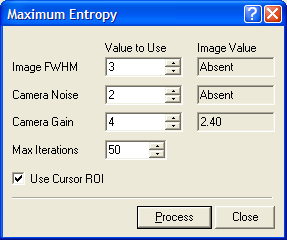
Maximum Entropy (Extension)
MaxEnt Module Specific
The Maximum Entropy command sharpens an image while reducing noise. This command implements the Maximum Entropy De-convolution, or "MaxEnt" Method. MaxEnt works best on images having high contrast and high signal to noise ratio, as shown in this example. Note: Maximum Entropy is an optional Extension Module for Mira and is not present in the command structure unless obtained separately.
Open the Maximum Entropy command dialog from the Process menu.

Maximum Entropy only works with luminance images. It will not work with RGB images. If you want to process an RGB image, you will need to extract the channels and process them separately. However, the dynamic range will be lower since each channel of the RGB image will have been reduced to 256 levels. For RGB images, it is best to perform Maximum Entropy processing on the luminance images before merging then into RGB form.
Using Iterations and ROI
These preferences are not part of the MaxEnt Algorithm but have a strong effect on the processing.
The number of iterations defines how many cycles you allow MaxEnt to repeat. More cycles is not necessarily better. Using too few iterations does not give MaxEnt a chance to converge to a good solution, whereas giving too many cycles can go past the optimum result and lead to an overly processed appearance full of artifacts—and it takes longer.
The ROI, or Region of Interest, is the enclosing rectangle where MaxEnt will be applied. This rectangle is defined by the Image Cursor. Choose the ROI so that it encloses only the region that needs to be enhanced. Enhancing the background is pointless and it just wastes time. It is often a total waste of time to leave Use Cursor ROI unchecked and attempt to get some decrease in background noise using the MaxEnt method.
|
tip |
When MaxEnt processing is active, you can break out of the loop at any time using the [Esc] key. |
For best results, the mathematical parameters fed to the MaxEnt algorithm need to be chosen carefully. Mira's implementation of Maximum Entropy processing reduces the parameter list to just 3 properties. Good results can be obtained for a large range of image properties using these 3 parameters: FWHM, Camera Noise, and Camera Gain. These are defined in the table below.
The Maximum Entropy dialog shows two sets of parameters:
The left column lists the values that will be used.
The right column lists the values taken from the image header.
The values in the right column are there as a guide. You may choose to use those values by entering them into the left column, or use them as a reference to choose values to try.
Maximum Entropy Parameters
|
FWHM |
The Full Width at Half Maximum (FWHM) of the point spread function for the image, measured in pixels. This measures the amount of smearing in the image. It is important not to overestimate this value or this could lead to rings around point sources and edge ripples. The value should not be less than about 2.0. |
|
Camera Noise |
For a CCD camera, this is the Readout Noise. This quantity is measured in electrons (e). For example, if the readout noise is 9.2e-, enter 9.2. |
|
Camera Gain |
The ratio of output counts to input electrons. This is a number like "2.8", meaning 2.8 electrons per count (or "ADU") in the image. Electronically, this is actually the "inverse gain" but is called the gain for a CCD camera. |
Spatial Filter Commands, Example of Maximum Entropy Processing